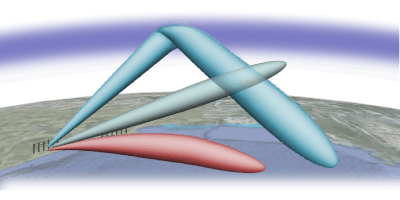Propagation of Electromagnetic Waves

Figure 1: sky wave, ground wave and space wave
The propagation of electromagnetic waves between the transmitting and receiving antenna is a very complex phenomena. It is nevertheless important to distinguish the different propagation methods of electromagnetic waves:
- Propagation by ground wave,
- Propagation by ionospheric wave (sky wave) and
- Propagation by direct wave (space wave).
The type of wave propagation is determined by the carrier frequency of the transmitted signal.
Ground Wave
For this type of propagation, the electromagnetic waves are conducted via the boundary of ground and atmosphere. The ground wave is the preferred propagation type for long distance communication using frequencies below 3 MHz (the earth behaves as a conductor for all frequencies below 5 MHz). The ground wave is also used for short distance communications using frequencies between 3 and 30 MHz.
Refraction in the Troposphere
As the lowest region of the Earth's atmosphere, the troposphere extends from the Earth's surface to a height of slightly over 7 miles. Virtually all weather phenomena occur in this region. Generally, the troposphere is characterized by a steady decrease in both temperature and pressure as height is increased. However, the many changes in weather phenomena cause variations in humidity and an uneven heating of the Earth's surface. As a result, the air in the troposphere is in constant motion. This motion causes small turbulences, or eddies, to be formed, as shown by the bouncing of aircraft entering turbulent areas of the atmosphere. These turbulences are most intense near the Earth's surface and gradually diminish with height. They have a refractive quality that permits the refracting or scattering of radio waves with short wavelengths. This scattering provides enhanced communications at higher frequencies.
When a radio wave is transmitted into layers with different densities, refraction, or bending of the wave, occurs. This refraction is a change in direction of a wave due to a change in its speed of propagation. Generally the amount of refraction that occurs in the earth' atmosphere depends on three main factors:
- the density of ionization of the layer,
- the frequency of the radio wave, and
- the angle at which the wave enters the layer.
Propagation by the Ionosphere
For this type of propagation, electromagnetic waves are reflected by a well defined layer of the atmosphere, called the ionosphere. The height and the amount of the ionospheric layers differ from day to night and are dependent of the season. Ionospheric waves are used for long distance communications in the decimetre-band. The ionospheric waves, after reflection by an ionospheric layer, are once again reflected by the earth surface. Those waves follow a kind of zig-zag pattern between ionospheric layer and earth surface and are able to travel over a very long distance.
At a height between 50 and 500 km above the earth surface, different layers are filled with electrical charged atoms, called ions. These ions can be charged positively or negatively. This ionisation is due to the U.V. rays radiated by the sun. The level of ionisation depends on the intensity of the sun radiation reaching the atmosphere. So, the ionisation is less during the night and changes constantly between sunrise and sunset. The ionisation is also dependent on the time of the year. The ionised layers form a plasma and are called ionosphere.
During daylight, 4 different layers exist, which are reduced to two at night. Each layer has the characteristics to attenuate the radio waves and given certain circumstances, to reflect them. This is the principle used by worldwide communications.
The layer, the farthest away from the earth surface is the F-layer which during daylight is split up into the F1 and F2 layer, each of them having a different ionisation level. Between 90 and 150 km altitude, a less intensively ionised layer exists, called the E-layer. The level with the lowest ionisation is the D-layer which completely disappears at night.
